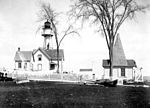Fort Totten (Queens)
1862 establishments in New York (state)American Civil War fortsBayside, QueensEast RiverForts in New York City ... and 11 more
Forts on the National Register of Historic Places in New York (state)Installations of the United States ArmyMilitary and war museums in New York (state)Military history of New York CityMuseums in Queens, New YorkNational Register of Historic Places in Queens, New YorkNature centers in New York CityNew York (state) in the American Civil WarNew York City Designated Landmarks in Queens, New YorkNew York City designated historic districtsParks in Queens, New York

Fort Totten is a former active United States Army installation in the New York City borough of Queens. It is located on the Willets Point peninsula on the north shore of Long Island. Fort Totten is at the head of Little Neck Bay, where the East River widens to become Long Island Sound. While the U.S. Army Reserve continues to maintain a presence at the fort, the property is now owned by the City of New York. The neighborhood has buses and served by MTA Regional Bus Operations Q13 and Q16 Buses.
Excerpt from the Wikipedia article Fort Totten (Queens) (License: CC BY-SA 3.0, Authors, Images).Fort Totten (Queens)
Murray Avenue, New York Queens County
Geographical coordinates (GPS) Address Nearby Places Show on map
Geographical coordinates (GPS)
| Latitude | Longitude |
|---|---|
| N 40.792027777778 ° | E -73.776083333333 ° |
Address
Murray Avenue
11359 New York, Queens County
New York, United States
Open on Google Maps






